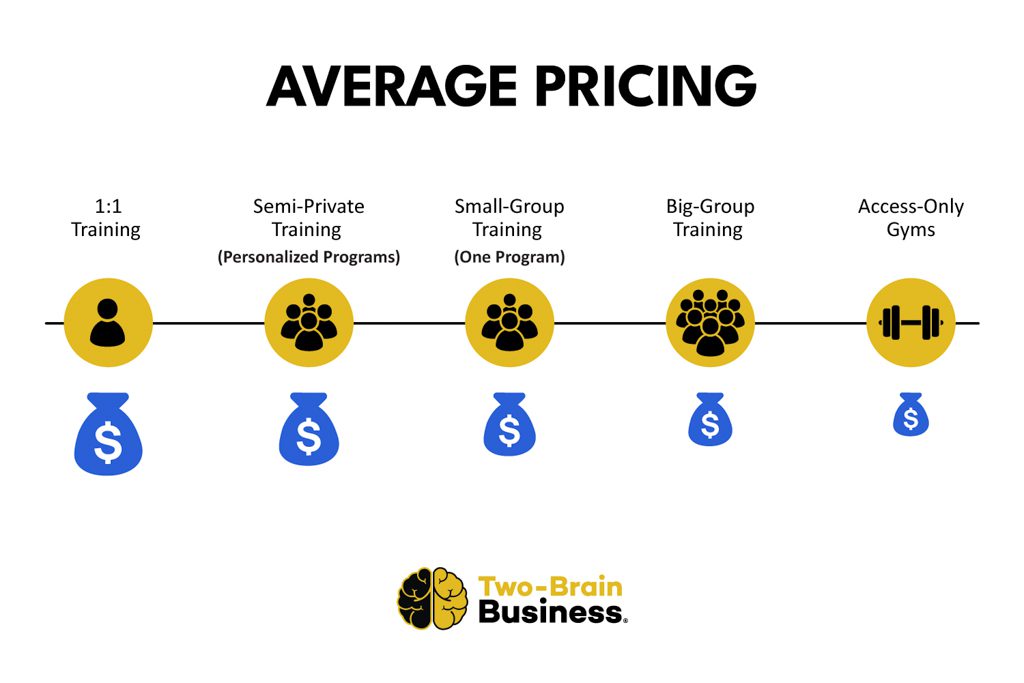You’ve probably heard about semi-private personal training or small-group personal training.
Though CrossFit “biz gurus” have been mostly talking about large-group coaching for the last decade, small-group personal training was Greg Glassman’s original model.
Unfortunately, the big-group coaching model has many problems, and now many CrossFit gyms are starting to pay attention to the alternatives.
Here, I’ll explain what semi-private personal training is, how it’s different from small-group personal training and why every CrossFit gym owner should consider it for their model.
Definitions
The Two-Brain process starts with finding the truth: We collect data from thousands of gyms every year, analyze it and publish it for free. You can get a copy of our most recent report here.

We don’t fall for the old stories and dogma, even when it comes from a CrossFit LLC source.
Let’s start by defining small-group personal training and semi-private personal training.
In small-group personal training, four to six people meet with a coach at a specific time. They follow the same warmup and workout, which is tailored to that specific group. Different groups might do different workouts on the same day.
Every person in the group gets a lot of personal attention. Each reviews their goals and progress with a coach regularly, and the group’s programming changes to reflect the needs of its members every few weeks.
In semi-private personal training, four to six people meet with a coach at a specific time. But in this model, each client has a personalized program. Their coach reviews their program before the session and rotates attention from one client to the next during the session.
Notice that I keep using “personal training” in the names of both services. That’s to remind you that these services do not fit in the industrialized model of “find a flaw and fix it” that’s common in big-group training. The coaching is much more specific, the touchpoints are much more frequent, and the service is far more valuable.
Data Dive
But why are we specifically recommending that CrossFit gyms adopt semi-private training into their models? Forget the dogma that “CrossFit is big-group training.”
Let’s look at “State of the Industry” numbers for the average CrossFit (big group) gym:
- Average number of clients—122.5
- Average revenue per client—$167.76
- Average number of clients per class—6.34
- Average hours coached by the owner per week—36.6
- Average pay per class—$32.50
Now, for comparison, the average semi-private (small group) gym:
- Average number of clients—62
- Average revenue per client—$230.18
- Average number of clients per session—4-6
- Average total hours worked by the owner per week—39.6
- Average pay per session—$45
Notice that most CrossFit gyms are actually coaching about the same number of clients per class as they would if they did small-group personal training. The difference is that they’re charging big-group rates.
So instead of coaching five people at once and earning $200, they’re coaching five people at once and earning $40.
Every hour of the day.
Evolution and Commoditization
The problem with big-group coaching now is commoditization.
When the first CrossFit gyms opened in major cities, they had the first-mover advantage. They attracted their first clients just because of novelty—they didn’t even have to advertise to jump over 200 members.
But those early adopters left after a year or two and opened their own gyms—at lower prices.
By 2015, you could find a CrossFit gym on every block in major cities, and CrossFit-influenced chains started to appear, such as Orangetheory and Fit Body Boot Camp. You could find dozens of independent bootcamps around, too.
They all looked the same to the common consumer, and that created downward price pressure.
Now most CrossFit gyms are running small groups of four to six people at big-group prices, and they’re paying big-group rent for space they don’t really need.
They can’t pay their coaches well, and many of the owners are making too little to survive, too.
For this reason, we recommend CrossFit gyms running the outdated big-group model sell “semi-private personal training” instead of “small-group personal training” because it’s hard for their clients to tell the difference between a “big group” option at $150 per month and a “small group” option priced at $300 per month.
Their clients have come to expect small groups for low rates already. Calling the new option “semi-private personal training” differentiates it enough to warrant the higher price.
The numbers alone are compelling, but here’s another twist: Greg Glassman’s gym didn’t do big-group coaching. They couldn’t fit a lot of people in the original gym in Santa Cruz, California. It was tiny. His model was high-value, small-group personal training. Clients paid close to personal training rates.
More Hard Data
Using 2024 “State of the Industry” data, here’s how average pricing for the most expensive membership stacks up:
- 1:1 training—$940
- Semi-private (small group) training—$477
- Big-group training (CrossFit)—$177
- Access-only gyms—$353

Now many of the top CrossFit gyms in the world are evolving to small-group personal training and semi-private personal training. With a smaller footprint, higher margin and lower churn, these gyms find the marketing pressure is much reduced, and—my favorite part—coaches can easily earn $80 per hour, instead of the current CrossFit average of $25.
No Gym Left Behind
Look, I wish the big-group model worked. I love coaching large groups.
But it doesn’t work for anyone long term. If CrossFit LLC collected any kind of data from its affiliates, this would have been obvious a decade ago.
Unfortunately, 20,000 affiliates have folded while trying this model because they didn’t know they had an alternative.
Now, Two-Brain is saving gyms because we start from absolute truth instead of just accepting the big-group myth that keeps getting passed from gym owner to gym owner.
We’ll be talking about this topic more and more because we have increasing amounts of great data, and, as always, we’ll share it with you for free.
For example, Oskar Johed—one of the most successful affiliate owners in the world and a Two-Brain mentor—has recently opened his third gym, and he’s using the small-group model.
We’ll get his story out to the affiliate community this year.
To find out today how data and the ideal model can save your gym, book a call here.

